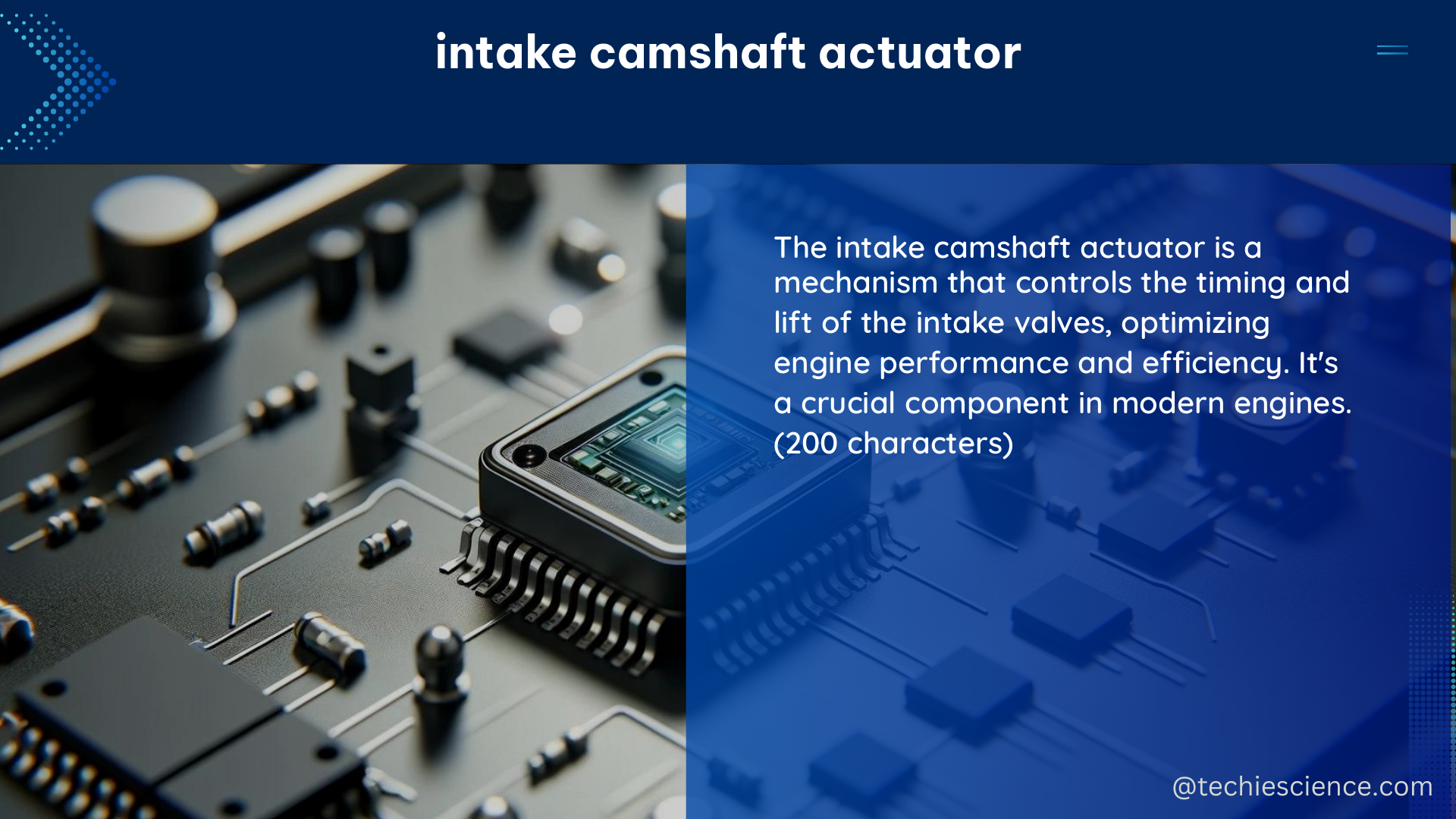The intake camshaft actuator, also known as the camshaft phaser, is a critical component in modern internal combustion engines. It plays a vital role in optimizing engine performance, fuel efficiency, and emissions by precisely controlling the timing of the intake valves. This comprehensive guide will delve into the intricacies of intake camshaft actuators, providing you with a deep understanding of their function, diagnostic techniques, and troubleshooting strategies.
Understanding the Intake Camshaft Actuator
The intake camshaft actuator is typically an electro-hydraulic system, consisting of a solenoid, a plunger, and a hydraulic chamber. The solenoid receives an electrical signal from the engine control module (ECM), which in turn moves the plunger and alters the hydraulic pressure within the chamber. This pressure change adjusts the phasing of the intake camshaft relative to the crankshaft, allowing for the optimization of intake valve timing.
Key Components and Their Functions
- Solenoid: The solenoid is the electro-magnetic component that receives the control signal from the ECM. When energized, the solenoid moves the plunger, which in turn adjusts the hydraulic pressure.
- Plunger: The plunger is the mechanical component that moves in response to the solenoid’s activation, altering the hydraulic pressure within the actuator chamber.
- Hydraulic Chamber: The hydraulic chamber is the sealed compartment that houses the pressurized hydraulic fluid. The pressure changes within this chamber are what drive the adjustment of the intake camshaft timing.
Diagnosing Intake Camshaft Actuator Issues

Proper diagnosis of intake camshaft actuator problems is crucial for maintaining engine performance and preventing further damage. Here are the key diagnostic steps and measurements to consider:
Resistance Measurements
Using a multimeter, measure the resistance of the intake camshaft actuator solenoid. A healthy solenoid should have a resistance between 15-30 ohms. Any significant deviation from this range may indicate a faulty solenoid.
Voltage Measurements
With the engine running, use a multimeter or a scan tool to check the voltage at the intake camshaft actuator solenoid. The solenoid should receive a battery voltage of around 12 volts. A significant drop in voltage may suggest a wiring or connection issue, while a constant voltage below 10 volts could indicate a problem with the ECM or battery.
Control Circuit Continuity
Ensure that the control circuit between the ECM and the intake camshaft actuator solenoid has continuity. Any breaks in this circuit can cause the solenoid to malfunction, resulting in poor engine performance or the illumination of a check engine light.
Hydraulic Pressure Measurement
The hydraulic pressure within the intake camshaft actuator chamber can be measured using a pressure gauge. The proper pressure range varies depending on the engine model, but any significant deviation from the manufacturer’s specifications may indicate a faulty actuator or a problem with the hydraulic system.
Snap Throttle Test
Perform a snap throttle test by rapidly accelerating the engine and observing the intake camshaft actuator’s response. A properly functioning actuator should adjust the camshaft timing accordingly, improving engine performance.
Troubleshooting Intake Camshaft Actuator Issues
If you suspect an issue with the intake camshaft actuator, follow these troubleshooting steps:
- Locate the Actuator: Identify the location of the intake camshaft actuator on your engine, which is typically mounted on the cylinder head near the intake camshaft.
- Check Resistance: Use a multimeter to measure the resistance of the intake camshaft actuator solenoid and compare the results with the manufacturer’s specifications.
- Test Voltage: With the engine running, use a multimeter or a scan tool to check the voltage at the intake camshaft actuator solenoid. Ensure the voltage is within the manufacturer’s specified range.
- Inspect the Control Circuit: Verify the continuity of the control circuit between the ECM and the intake camshaft actuator solenoid. Look for any breaks or issues in the wiring.
- Measure Hydraulic Pressure: Use a pressure gauge to measure the hydraulic pressure within the intake camshaft actuator chamber. Compare the results with the manufacturer’s recommended pressure range.
- Perform a Snap Throttle Test: Rapidly accelerate the engine and observe the intake camshaft actuator’s response. A properly functioning actuator should adjust the camshaft timing accordingly.
If the diagnostic tests reveal any issues with the intake camshaft actuator, it’s essential to address the problem promptly to prevent further engine damage and maintain optimal performance.
Conclusion
The intake camshaft actuator is a complex and critical component in modern internal combustion engines. By understanding its function, diagnostic techniques, and troubleshooting strategies, you can effectively maintain and repair this vital system, ensuring your engine operates at peak efficiency and performance. This comprehensive guide has provided you with the knowledge and tools necessary to tackle any intake camshaft actuator-related issues you may encounter.
References
- How to test cam/crank actuator solenoids (P0010, P0013 … – YouTube, https://www.youtube.com/watch?v=6B7HrBN2tvY
- I have a 2021 Chevy Silverado 4×4 custom Im trying to figure out where the exhaust camshaft sleeve position sensor 2 is – JustAnswer, https://www.justanswer.com/chevy/mlgqo-2021-chevy-silverado-4-4-custom-trying-figure.html
- Intake/Exhaust Camshaft Actuator Solenoid test (P0010, P0011) – YouTube, https://www.youtube.com/watch?v=_RF4yct8J54
- Code P0010 Camshaft Actuator – Chevy HHR Network, https://www.chevyhhr.net/forums/problems-service-repairs-42/code-p0010-camshaft-actuator-33762/
- 0278 Cam actuator short to ground – MBWorld.org Forums, https://mbworld.org/forums/c63-amg-w204/721855-0278-cam-actuator-short-ground.html

The lambdageeks.com Core SME Team is a group of experienced subject matter experts from diverse scientific and technical fields including Physics, Chemistry, Technology,Electronics & Electrical Engineering, Automotive, Mechanical Engineering. Our team collaborates to create high-quality, well-researched articles on a wide range of science and technology topics for the lambdageeks.com website.
All Our Senior SME are having more than 7 Years of experience in the respective fields . They are either Working Industry Professionals or assocaited With different Universities. Refer Our Authors Page to get to know About our Core SMEs.